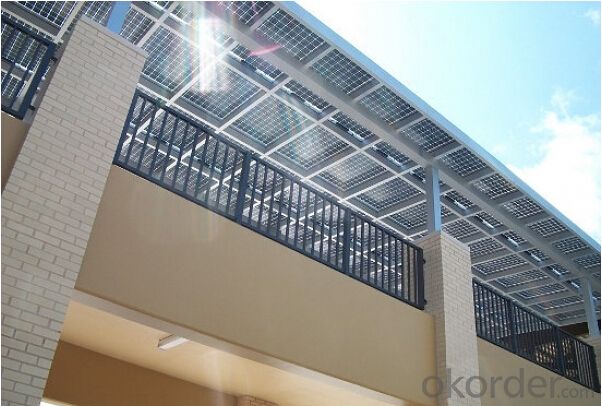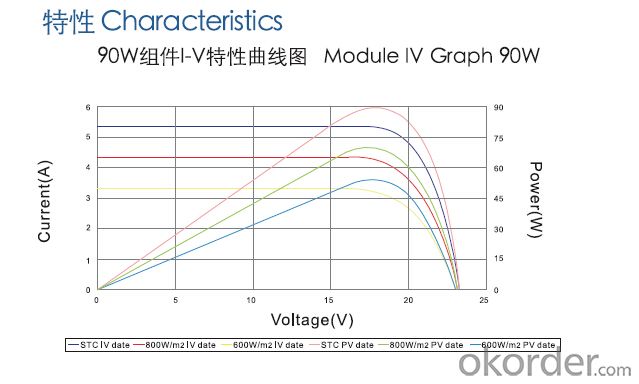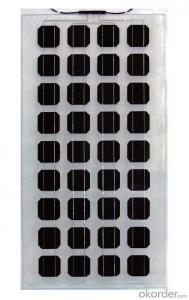Double Glass Mono(Poly) Crystalline silicon Solar Panel Model CR090M-B
- Loading Port:
- Tianjin
- Payment Terms:
- TT OR LC
- Min Order Qty:
- 5 pc
- Supply Capability:
- 100 pc/month
OKorder Service Pledge
OKorder Financial Service
You Might Also Like
1. Structure of Double Glass Mono(Poly) Crystalline Silicon Solar Panel Model CR090M-B
Double glass Mono(Poly) crystalline silicon solar panel(hereinafter refferred as "double glass solar panel" ) has advantage of beautiful apperence and high transmissivity by using the double glass on both sides of the solar panel, compared to the normal crystalline silicon solar panel. So double glass solar panel is widly used in the BIPV and other constructions such as solar intelligent window, solar pavilion and photovoltaic glass roof and wall.
2. Main Features of Double Glass Mono(Poly) Crystalline silicon Solar Panel Model CR090M-B
High-efficient solar cells
High transmissivity low-iron toughened glass
Anodized aluminum frame
Water resistant junction box
Design to meet unique demand of customer
25 year poweroutput warranty
3.Double Glass Mono(Poly) Crystalline silicon Solar Panel Model CR090M-B Images

4. Double Glass Mono(Poly) Crystalline silicon Solar PanelModel CR090M-B Specification
MODEL | CR090M-B |
Maximum Power (Pm) | 90W |
Open-circuit voltage (Voc) | 22.2V |
Short-circuit current (Isc) | 5.29A |
Volatage at Pmax (Vmp) | 18.3V |
Current at Pmax (Imp) | 4.92A |
Maximum system voltage | 1000VDC |
Operating temperature | -40℃ to +60℃ |
Dimension of module(mm) | 1574×802×8 |
Weight of module (kg) | 23.0 |
Power tolerance | ±5% |

5. FAQ
(1) Why the double glass solar panel is more expessive than normal solar panel?
Because manufacturerer should face the technical difficulty in encapsulation process, and it costs more to make a lot of experiment to find a good packaging technology and get an excellent packaging method.
(2) How long for the manufacture process?
It depends on the payment terms, for we need to arrange the purchasing materials especially for the glass. If possible we prefer 100% by T/T to other payment terms, and we will put into production as soon as possible.
(3) Can we have test report of the solar panels?
Surely you can, once we have finished quality test after production, we have the technical details for the test report.
- Q:I need to reduce the average monthly home electricity bill by powering some of the household appliances using solar panels. Can I use a 250 watt solar panel to power a medium sized upright fridge?
- Solar panel alone? No. With the appropriate storage system and inverter, perhaps. You will need to do the calculation - as follows: In a solar day that averages about eight hours, you will generate about 67% of your rated output over those 8 hours. That means you will have made 340 watts. Your refrigerator will run for about four (4) hours per day on average if you are very careful about opening and closing. If you have a 400-watt (average-when-running) fridge, you will have a small cushion that will be absorbed by inverter losses, charger losses and so forth. So, with an adequate set of storage batteries, a good charger and a good inverter, you just might be able to operate that small fridge. No icemaker, no other power drains. But, two 250-watt panels would be better.
- Q:Can solar panels be installed on train stations?
- Yes, solar panels can be installed on train stations. In fact, many train stations around the world are adopting solar energy systems to power their operations and reduce their carbon footprint. Solar panels are installed on the roofs or canopies of train stations to harness sunlight and generate electricity, which can be used for lighting, heating, cooling, and other station facilities. This renewable energy source makes train stations more sustainable and helps in the transition towards a greener transportation system.
- Q:Can solar panels be used in agriculture?
- Yes, solar panels can be used in agriculture. They can provide clean and renewable energy to power various agricultural processes such as irrigation systems, livestock operations, and crop drying. Additionally, solar panels can be installed on farm buildings or in open fields, helping farmers reduce their reliance on traditional energy sources and lower their carbon footprint.
- Q:Can solar panels be installed on asphalt shingles?
- Yes, solar panels can be installed on asphalt shingles. However, it is important to ensure that the shingles are in good condition and can support the weight of the panels. Proper installation techniques and mounting systems designed for asphalt shingles should be used to prevent any damage to the roof.
- Q:Can solar panels be installed on a church or place of worship?
- Yes, solar panels can be installed on a church or place of worship. Many religious organizations have taken steps to embrace renewable energy and reduce their carbon footprint by installing solar panels on their rooftops or open spaces. Installing solar panels not only helps to generate clean and sustainable electricity but also serves as a visible symbol of the organization's commitment to environmental stewardship.
- Q:Can solar panels be used to power a university?
- Yes, solar panels can be used to power a university. By installing a sufficient number of solar panels on campus buildings or in open spaces, universities can generate a significant amount of clean and renewable energy. This can help reduce reliance on fossil fuels, decrease electricity costs, and contribute to a more sustainable campus. Additionally, advancements in solar technology have made it more efficient and affordable, making it a viable option for universities looking to transition to renewable energy sources.
- Q:please help me
- Hint: It's behind the foreground.
- Q:What materials are solar panels made of?
- Solar panels are typically made of photovoltaic (PV) cells, which are primarily composed of silicon, along with other materials such as metal frames, glass, and encapsulation materials.
- Q:Can solar panels be used for air conditioning?
- Yes, solar panels can be used for air conditioning. Solar panels generate electricity from sunlight, which can be used to power air conditioning units. By using solar energy, homeowners and businesses can reduce their reliance on traditional electricity sources and decrease their carbon footprint. However, the efficiency and effectiveness of using solar panels for air conditioning may vary depending on factors such as the size of the solar system, location, and energy requirements of the air conditioning unit.
- Q:I have made a 5v dc 52watt solar panel and I going to be trying to charger 4 2v dc 55ah batteries. I get about 6 hours of sun on my panel. Spec below, is that a big enough panel to charge the batteries???I have 30 3x6 solar cells wired together Cell Specifications: (Watts): .75 Wp (Amps): 3.5 Imax (Volts): 0.5 V max which is where I got my 5g 52watt max (if math is wrong plz tell me) The Battery type: 2Volt 55.0ah NB Sealed Lead Acid Battery. I am using a mppt solar charger.
- Technically, any solar panel can charge any battery, but it would take quite a long time do do so if it is a large battery. If you are aware of the voltage and either amp or watt rating of the unit that is usually used to charge the battery, the solar panel should have a similar power output to that charger to work well. amps and watts are quite similar, and can be converted with this simple formula: W=watts; V=volts; A=amps; W/V=A; V*A=W; When charging batteries, it is always wise to use less amps than needed, and roughly the same voltage as the battery being charged. The less amps used to charge batteries means the battery will take longer to charge but will last a lot longer in the long-term. Your solar panel should be sufficient to charge the battery, but you should test charge it to see if it works well. I recommend using a multimeter to check the batteries voltage every couple of hours. Once the battery reaches 2v, it should be fully charged. You should also check the amps in case they are not at the expected value (take caution when checking amps with a multimeter, when i do it i always end up melting my multimeter leads). The battery should be fully charged from anywhere between 6-48 hours. if it is charging faster, the solar panel has too much power. if it doesn't charge in this time frame, the solar panel is not powerful enough.
1. Manufacturer Overview |
|
|---|---|
| Location | |
| Year Established | |
| Annual Output Value | |
| Main Markets | |
| Company Certifications | |
2. Manufacturer Certificates |
|
|---|---|
| a) Certification Name | |
| Range | |
| Reference | |
| Validity Period | |
3. Manufacturer Capability |
|
|---|---|
| a)Trade Capacity | |
| Nearest Port | |
| Export Percentage | |
| No.of Employees in Trade Department | |
| Language Spoken: | |
| b)Factory Information | |
| Factory Size: | |
| No. of Production Lines | |
| Contract Manufacturing | |
| Product Price Range | |
Send your message to us
Double Glass Mono(Poly) Crystalline silicon Solar Panel Model CR090M-B
- Loading Port:
- Tianjin
- Payment Terms:
- TT OR LC
- Min Order Qty:
- 5 pc
- Supply Capability:
- 100 pc/month
OKorder Service Pledge
OKorder Financial Service
Similar products
New products
Hot products
Related keywords






























